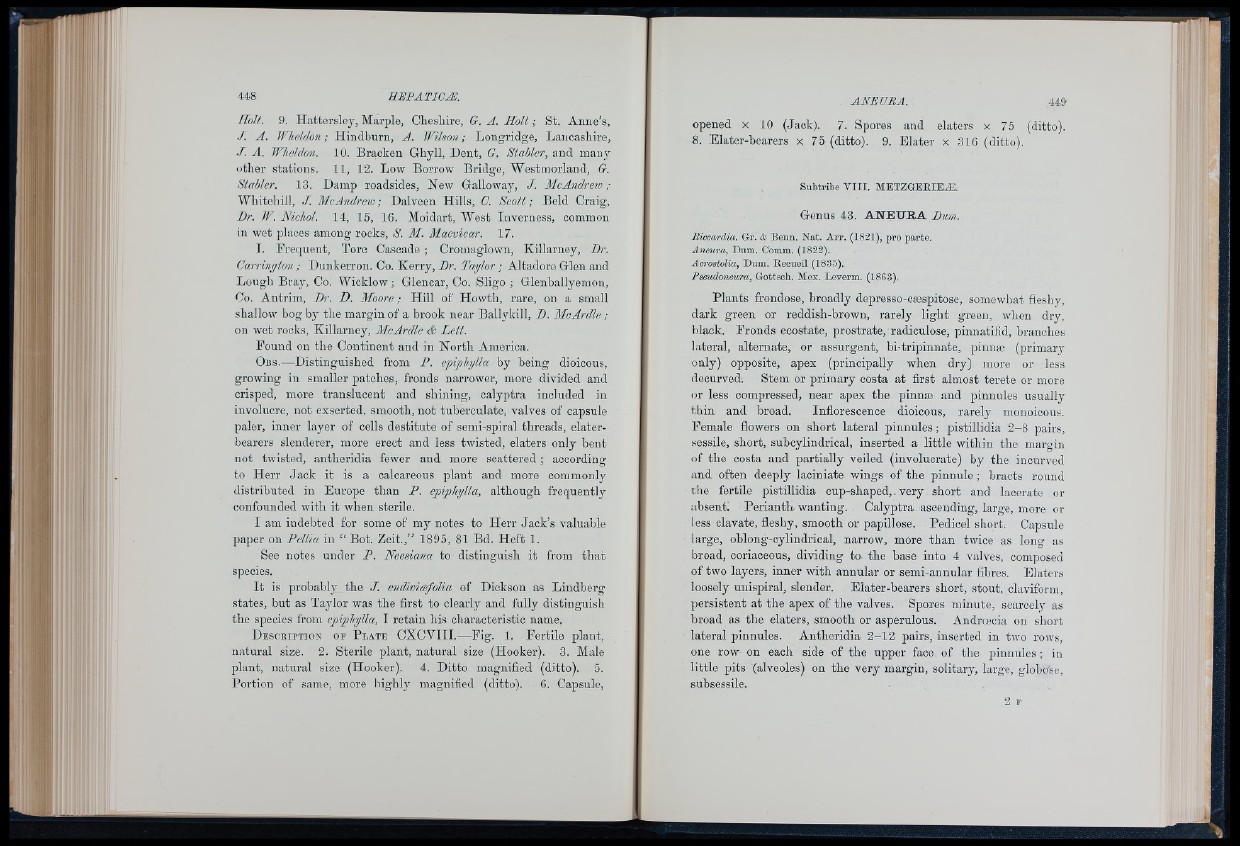
Holf. 9. Hatterslej', Marple, Cliesliire, G. A. H o lt; St. Anne’s,
■I. A. IVheldon; Hindburn, A. Wilson; Longridge, Lancashire,
■I. A. Wheldon. 10. Bracken Ghyll, Dent, G. Stahler, and many
otlier stations. 11, 12. Low Borrow Bridge, Westmorland, G.
Stahler. 13. Damp roadsides. New Galloway, J. McAndrew;
Whitehill, J. McAndreio; Dalveen Hills, C. Scott; Beld Craig,
Dr. W. Nichol. 14, 15, 16. Moidart, West Inverness, common
in wet places among rocks, S. M. Macvicar. 17.
I. Frequent, Tore Cascade ; Cromaglown, Killarney, Dr.
Carrington; Dunkerron. Co. Kerry, Dr. Taglor; Altadore Glen and
Lough Bray, Co. Wicklow; Glencar, Co. Sligo ; Glenballyemon,
Co. Antrim, Dr. D. Moore; Hill of Howth, rare, on a small
shallow bog by the margin of a brook near Ballykill, D. McArdle ;
on wet rooks, Killarney, McArdle & Lett.
Found on the Continent and in North America.
O b s .—Distinguished from P. epiphylla by being dioicous,
growing in smaller patches, fronds narrower, more divided and
crisped, more translucent and shining, calyptra included in
involucre, not exserted. smooth, not tuberculate, valves of capsule
paler, inner layer of cells destitute of semi-spiral threads, elater-
bearers slenderer, more erect and less twdsted, elaters only bent
not twisted, antheridia fewer and more scattered; according
to Herr Jack it is a calcareous plant and more commonly
distributed in Europe than P. epiphylla, although frequently
confounded with it when sterile.
I am indebted for some of my notes to Herr Jack’s valuable
paper on PeUia in “ Bot. Zeit.,” 1895, 81 Bd. Heft 1.
See notes under P. Neesiana to distinguish it from that
species.
I t is probably the J. endiviafolia of Dickson as Lindberg
states, but as Taylor was the first to clearly and fully distinguish
the species from epiphylla, I retain his characteristic name.
D escription oe P late CXCVIII.—Fig. 1. Fertile plant,
natural size. 2. Sterile plant, natural size (Hooker). 3. Male
plant, natural size (Hooker). 4. Ditto magnified (ditto). 5.
Portion of same, more highly magnified (ditto). 6. Capsule,
opened x 10 (Jack). 7. Spores and elaters x 75 (ditto).
8. Elater-bearers x 75 (ditto). 9. Elater x 316 (ditto).
Subtribe V I I I . M B T Z G E E IE Æ .
Genus 43. ANEIIRA Dmn.
Riccardia. Gr. & Benn. Nat. A rr. (18 2 1), pro parte.
Aneura, Dam. Comm. (1822).
Acrostolia, Dum. Recueil (1885).
Pseudoneura, Gottsch. Mex. Leverm. (1863).
Plants frondose, broadly depresso-cæspitose, somewhat fleshy,
dark green or reddish-brown, rarely light green, when dry,
black. Fronds ecostate, prostrate, radiculose, pinnatifid, branches
lateral, alternate, or assurgent, hi-tripinnate, pinnæ (primary
only) opposite, apex (principally when dry) more or less
decurved. Stem or primary costa at first almost terete or more
or less compressed, near apex the pinnæ and pinnules usually
thin and broad. Inflorescence dioicous, rarely iiioiioicous.
Female flowers on short lateral pinnules ; pistillidia 2-8 pairs,
sessile, short, subcylindrioal, inserted a little within the margin
of the costa and partially veiled (involúcrate) by the incurved
and often deeply laciniate wings of the pinnule ; bracts round
the fertile pistillidia cup-shaped,. very short and lacerate or
absent. Perianth wanting. Calyptra ascending, large, more or
less clavate, fleshy, smooth or papillose. Pedicel short; Capsule
large, oblong-cylindrical, narrow, more than twice as long as
broad, coriaceous, dividing to the base into 4 valves, composed
of two layers, inner with annular or semi-annular fibres. Elaters
loosely unispiral, slender. Elater-bearers short, stout, clavifonn,
persistent at the apex of the valves. Spores minute, scarcely as
broad as the elaters, smooth or asperulous. Andrcecia on short
lateral pinnules. Antheridia 2-12 pairs, inserted in two rows,
one row on each side of the upper face of the qiinniiles ; in
little pits (alveoles) on the very margin, solitary, large, globdse,
snbsessile.
2 E